How to Choose the Right Table Tennis Balls?

When it comes to table tennis, choosing the right equipment is crucial for an optimal playing experience. While the table and paddles are essential, the significance of selecting the right table tennis balls should not be underestimated. Table tennis balls vary in their material, quality, and specifications, all of which can greatly impact the game. In this guide, we will walk you through the key factors to consider when choosing table tennis balls, ensuring that you make an informed decision that enhances your playing performance.
1. Understand the Types of Table Tennis Balls: Table tennis balls are divided into groups according to their function and composition. Table tennis balls come in two primary categories:
a. Celluloid balls:
Celluloid balls were originally commonly used but have since been phased out owing to safety concerns. Players are at risk since they are very combustible and prone to breaking.
b. Plastic Balls:
In place of celluloid balls, plastic balls are now the norm in table tennis. They are constructed of polyethylene or ABS (acrylonitrile butadiene styrene). Balls made of plastic have better longevity, a more constant bounce, and better safety features.
2. Consider the Ball Quality: Table tennis ball quality has a big effect on the game. Following are some criteria to consider while evaluating ball quality:
a. Star rating
Table tennis balls are given a star rating, with numbers ranging from one to three. Three-star balls are of the finest caliber and permitted for official tournaments. A greater star grade denotes superior quality.
b. Roundness and Balance:
Seek out perfectly spherical, evenly-balanced balls. The trajectory and bounce of the ball might be impacted by flaws, which can cause gameplay discrepancies.
c. Seam integrity
Check the ball's seam to make sure it is securely bonded and does not protrude. Better spin and precision are encouraged by a smooth surface.
3. Select the Ball Color: Table tennis balls often come in white and orange, however other colors also exist. Depending on the lighting in your playing location, the color you choose might affect visibility. Think about the following elements:
a. Lighting:
If you're playing in a well-lit area, both orange and white balls are easy to see. Orange balls, however, typically offer stronger contrast against the table and background in dimly lit or poorly lit areas.
b. Personal Preference:
Due to personal preference or visual acuity, some players discover that they can track the ball better with a certain color. Try both colors out to see which one you like the most.
4. Determine the Ball Grade: Table tennis balls are frequently graded according to their intended function in addition to star ratings. These rankings might be:
a.Training balls:
Training balls are designed for practice sessions and are an excellent choice for newcomers and recreational players because they are both inexpensive and sturdy.
b.Competition Balls:
These balls are of the finest caliber and are appropriate for use in recognised competitions and in competitive play. They perform and exhibit with outstanding consistency.
5. Test Different Brands and Models: Each player has their own tastes and ways of playing. To locate the table tennis balls that are perfect for you, it is advised to check out several brands and models. During your practice sessions or friendly matches, pay close attention to how each ball feels, bounces, and responds to spin.
For a fun and competitive playing experience, selecting the appropriate table tennis balls is crucial. You may make an informed choice that improves your performance at the table by taking into account variables such ball type, quality, color, grade, and personal preferences. Remember that finding the ideal ball could necessitate some trial and error, so don't be afraid to try out several brands and types until you find the ones that are most effective for you.
